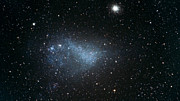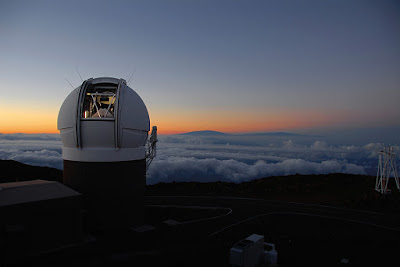This view shows the entire sky
in gamma ray radiation, at energies greater than 1 GeV, based on five
years of data from the Large Area Telescope instrument on NASA's Fermi
Gamma-ray Space Telescope. Brighter colours indicate brighter gamma-ray
emission. The large bright band in the middle is the emission from our
own Galaxy. Credit: NASA/DOE/Fermi LAT Collaboration
Researchers from the Max Planck Institute for
Astrophysics and the University of Amsterdam GRAPPA Center of Excellence
just published the most precise analysis so far of the fluctuations in
the gamma-ray background. They used more than six years of data gathered
by the Fermi Large Area Telescope and found two different source
classes contributing to the gamma-ray background. No traces of a
contribution of dark matter particles were found in the analysis. The
study was performed with an international collaboration of researchers
and is published in the journal Physical Review D.
Gamma rays are particles of light, or photons, with the highest
energy in the universe, invisible to the human eye. The most common
emitters of gamma rays are blazars: supermassive black holes at the
centres of galaxies. In smaller numbers, gammy rays are also produced by
a certain kind of stars called pulsars and in huge stellar explosions
such as supernovae.
In 2008 NASA launched the Fermi satellite to map the gamma-ray universe
with extreme accuracy. The Large Area Telescope, mounted on the Fermi
satellite, has been taking data ever since. It continuously scans the
whole sky every three hours. The majority of the detected gamma rays is
produced in our own Galaxy (the Milky Way), but the Fermi telescope also
managed to detect more than 3000 extragalactic sources (according to
the latest count performed in January 2016). However, these individual
sources are not enough to explain the total amount of gamma-ray photons
coming from outside our Galaxy. In fact, about 75% of them are
unaccounted for.
Isotropic gamma-ray background
As far back as the late 1960’s, orbiting observatories have found a
diffuse background of gamma rays streaming from all directions in the
universe. If you had gamma-ray vision, and looked at the sky, there
would be no place that would be dark.
The source of this so-called isotropic gamma-ray background is
hitherto unknown. This radiation could be produced by unresolved
blazars, or other astronomical sources too faint to be detected with the
Fermi telescope. Parts of the gamma-ray background might also hold the
fingerprint of the illustrious dark matter particle, a so-far undetected
particle held responsible for the missing 80% of the matter in our
universe. If two dark matter particles collide, they can annihilate and
produce a signature of gamma-ray photons.
Fluctuations
in the isotropic gamma-ray background, based on 81 months of data.
Emission from our own Galaxy, the Milky Way, is masked in grey. Credit: Mattia Fornasa, UvA/Grappa
Fluctuations
“The analysis and interpretation of fluctuations of the diffuse
gamma-ray background is a new research area in high-energy
astrophysics,” explains Eiichiro Komatsu at the Max Planck Institute for
Astrophysics, who developed the necessary analysis tools for
fluctuations in this radiation. He was also part of the team that for
the first time reported fluctuations in the gamma ray background in
2012. For this latest analysis, the researchers used 81 months of data
gathered by the Fermi Large Area Telescope – much more data and with a
larger energy range than in previous studies.
The scientists were able to distinguish two different contributions
to the gamma-ray background. One class of gamma-ray sources is needed to
explain the fluctuations at low energies (below 1 GeV), and another
type of sources is needed to generate the fluctuations at higher energy –
the signatures of these two contributions is markedly different.
The gamma rays in the high-energy ranges – from a few GeV up – are
likely originating from unresolved blazars, the researchers suggest in
their paper. Further investigation of these potential sources is
currently under way. However, it seems much harder to pinpoint a source
for the fluctuations with energies below 1 GeV. None of the known
gamma-ray emitters have a behaviour that is consistent with the new
data.
Constraints on dark matter
So far, the Fermi telescope has not detected any conclusive
indication of gamma-ray emission originating from dark-matter particles.
Also this latest study showed no indication of a signal associated with
dark matter. “Our measurement complements other search campaigns that
used gamma rays to look for dark matter,” says lead author Mattia
Fornasa from the University of Amsterdam. “It confirms that there is
little room left for dark matter induced gamma-ray emission in the
isotropic gamma-ray background.”
The precision of the fluctuation measurement has improved markedly
since the first result in 2012. “I am glad to see that our measurements
provide significant new insights into the origin of the gamma-ray
background,” says Komatsu.
“My original motivation to do this analysis in 2006 was to find
evidence for gamma-rays from dark matter particles. Well, we have not
found gamma-rays from dark matter yet,” Komatsu concedes, “but I am
still excited about our measurements leading to a new understanding of
populations of astrophysical gamma-ray sources such as blazars. I have
not given up hope on finding gamma-rays from dark matter yet though, and
we have some new ideas on how to improve our method.”
Contact
 Komatsu, Eiichiro
Managing director
Phone:2208
Komatsu, Eiichiro
Managing director
Phone:2208
Email: ekomatsu@mpa-garching.mpg.de
 Hämmerle, Hannelore
Press officer
Phone: 3980gas
Email: hanne@mpa-garching.mpg.de
Original Publication
Hämmerle, Hannelore
Press officer
Phone: 3980gas
Email: hanne@mpa-garching.mpg.de
Original Publication
Mattia Fornasa, Alessandro Cuoco, Jesús Zavala,
Jennifer M. Gaskins, Miguel A. Sánchez-Conde, German Gomez-Vargas,
Eiichiro Komatsu, Tim Linden, Francisco Prada, Fabio Zandanel and Aldo
Morselli
The angular power spectrum of the diffuse
gamma-ray emission as measured by the Fermi Large Area Telescope and
constraints on its Dark Matter interpretation
Phys. Rev. D 94, 123005, 9 December 2016
M. Ackermann et al.
Anisotropies in the diffuse gamma-ray background measured by the Fermi LAT
Phys. Rev. D 85, 083007, 2012
























